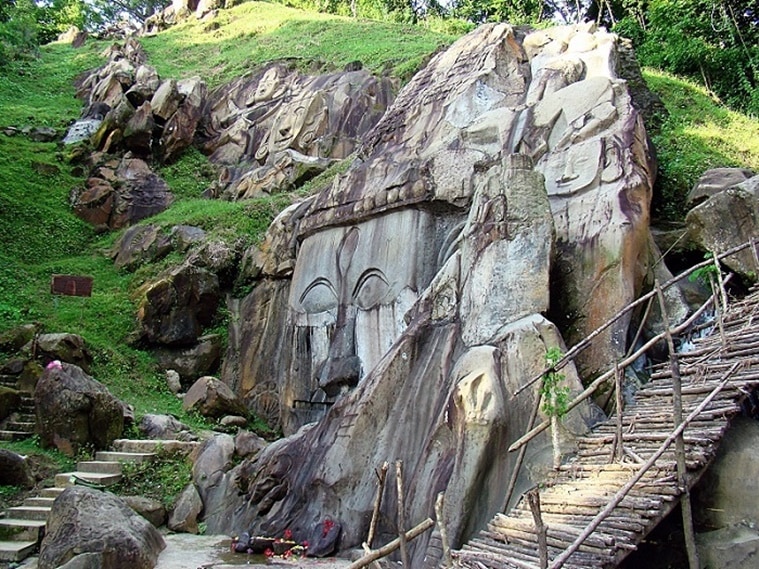📣 For more lifestyle news, click here to join our WhatsApp Channel and also follow us on Instagram
All about Tripura’s Unakoti, the ‘Angkor Wat of the North-East’ seeking UNESCO world heritage tag
Dating back to the 7th-9th centuries, Unakoti is a 'Shaiba' (Saivite) pilgrimage site with marvellous rock carvings, murals with their primitive beauty and waterfalls
 Rock-cut idol at Unakoti heritage site (Source: unakoti.nic.in)
Rock-cut idol at Unakoti heritage site (Source: unakoti.nic.in) Unakoti, famously known as the ‘Angkor Wat of the North-East’, is vying for a UNESCO world heritage tag with both the government and ASI working to preserve the lakhs of Shaivite rock carvings figures and images of gods and goddesses. “The structures of the rock-cut sculptures are gigantic and have distinct mongoloid features and display almost the same mystical charm as the spellbinding figures in the Angkor Wat temple of Cambodia. So call it the Angkor Wat of North-East,” said Panna Lal Roy, a well-known historical writer of the state, who has been studying the sculptures for many years, told PTI.
The report stated that the Centre has approached UNESCO to declare it a World Heritage Site and has recently granted Rs 12 crore to the state for developing the place as a major tourist destination. The Tripura government is developing areas near the site to encourage tourists to visit this treasure of the North East, Roy added.
Dating back to the 7th-9th centuries, Unakoti is a ‘Shaiba’ (Saivite) pilgrimage site with marvellous rock carvings, murals with their primitive beauty and waterfalls. Literally, Unakoti means ‘one less one crore’ in Hindi and Bengali and it is believed that these many rock carvings (ninety-nine lakh ninety-nine thousand nine hundred and ninety-nine) are present here. In the local Kokborok language, it is called Subrai Khung and is the central tourist spot of the Unakoti District in the Kailashahar Subdivision of Tripura.
The place is not just stunningly picturesque but also has great mythological significance. According to Hindi mythology, when Lord Shiva was going to Kashi along with one crore gods and goddesses, he made a night halt at this location. He asked all his fellow gods and goddesses to wake up before sunrise and proceed for Kashi. It is believed that in the morning, except Shiva, none of them could wake up so he set out for Kashi alone, cursing others to become stone images. As a result of this curse, ninety-nine lakh ninety-nine thousand nine hundred and ninety-nine stone images and carvings continue to be present at Unakoti.
 Brahma Kundo at Unakoti (Source: unakoti.nic.in)
Brahma Kundo at Unakoti (Source: unakoti.nic.in)
A local tribal myth says that Kallu Kumhar, a devotee of goddess Parvati who wanted to accompany Shiva-Parvati to Mount Kailash, was the maker of these idols. It is believed that Shiva agreed to take Kallu to their abode in Mount Kailash on Parvati’s request only if he would make one crore idols of Shiva in one night. However, by the morning, he could complete only one less than a crore idols and Shiva left the potter behind with his idols in Unakoti.
The images found at Unakoti are of two types, namely rock-carved figures and stone images. Among the rock-cut carvings, the central Shiva head and gigantic Ganesha figures deserve special notice. The central Shiva head is known as ‘Unakotiswara Kal Bhairava’ and is about 30 feet high including an embroidered head-dress which itself is 10 feet high. On each side of the head-dress of the central Shiva, there are two full-size female figures – one of Durga standing on a lion, and another female figure on the other. In addition, three enormous images of Nandi Bull are found half buried in the ground.
Tourists are in for a visual delight at this location as these carvings and images are located in a beautifully landscaped forest area with green vegetation all around. Every year, a big fair, known as ‘Ashokastami Mela’, takes place in the month of April and is visited by thousands of pilgrims.
How to reach Unakoti?
The nearest airport is Agartala which is around 178 km from Kailashahar by round. The site is another 8 km from this town. If you are opting for a train, the nearest railway station is at Kumarghat which is 26 km from Kailashahar. One can also travel by road as it is well connected to the nearest cities such as Guwahati, Silchar, Shillong and Agartala.
📣 For more lifestyle news, follow us on Instagram | Twitter | Facebook and don’t miss out on the latest updates!
📣 For more lifestyle news, click here to join our WhatsApp Channel and also follow us on Instagram
Photos
- 01
- 02
- 03
- 04
- 05



























